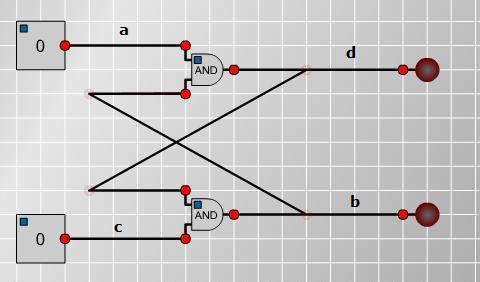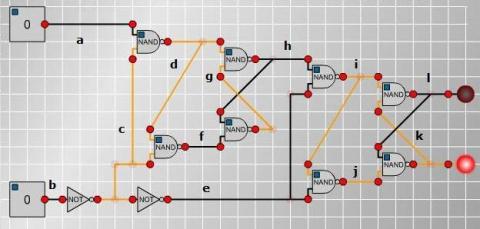Circular circuitry
Problem
This problem involves circuits which feed back into themselves: The output of a gate can be traced through the circuit back into the input of the same gate! This can lead to all sorts of interesting behaviour, which will be explored in this problem. Please note that the gates here are not interactive: they are thought experiments .
What will happen when you switch on these circuits?
What will happen if you change the gates to different types?
The following two circuits have the same gates. Look carefully at the wires which are switched on. What do you notice? What do you think will happen when the switches are flicked on and then flicked off?
Can you create your own feedback circuits? Investigate their properties.
Click here for a poster of this problem.
NOTES AND BACKGROUND
A key concept in computing is that of random access memory : whilst computers logically process commands they are also able to store user inputs whilst a procedure is being followed. Memory is built using logic gate circuits which feed back into themselves. The most simple of these is the 'flip-flop' which you can read about in the Wikipedia article . The flip-flop is a device which has two different stable states, and can thus 'remember' if a switch has previously been flipped.
Getting Started
Think of a circuit as a flow of electrons. As a switch is flipped on, electrons flow from the switch. What happens when they reach a gate? Trace the path of the current around the circuit.
This problem involves the sort of thinking typically found formally in Decision Mathematics modules, but can be attempted armed only with a basic understanding of logic and truth tables.
Student Solutions
All credit to Alex Bramham, for this excellent and complete solution;
Each wire can be either on or off. Wires that must be the same have been assigned the same variable. The variables are 1 when the wire is on, and 0 when off. Relationships between these variables model the circuit.
Circuit 1

Circuit 2

Circuit 3

Teachers' Resources
Why do this problem?
This problem presents a fascinating logical exercise. Forcing students to deal with logical inconsistency will give an excellent mental workout. Decisions need to be made as to how to decide on 'consistent' configurations. This will challenge students' perceptions: the very simple concept of a logic gate can quickly lead to deep logical issues.Possible approach
This problem might create interesting discussion as students struggle with understanding the behaviour of the circuits. See how the discussion evolves. Try to encourage precision in the statements from the students as they grapple with the inconsistencies.Key questions
- What do you see?
- What will happen when a switch is flicked?
- Some wires contain 'trapped' current. Are these circuits consistent without this trapped current?
- If a switch is switched on and then off, does the circuit return to its original state?
- Clearly we could make these circuits out of physical wires and gates. What would happen in real life if they were switched on?
